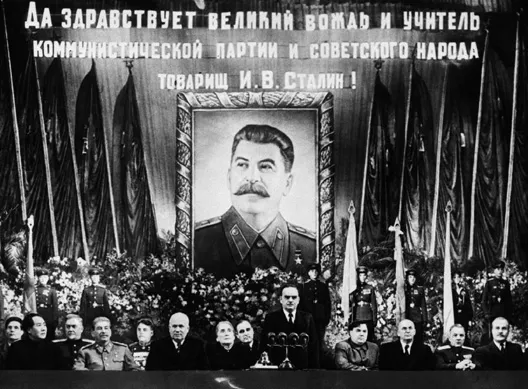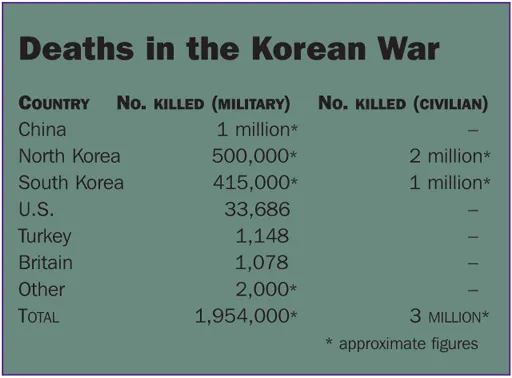
eBook - ePub
The Cold War
Reg Grant, Britannica Digital Learning
This is a test
Buch teilen
- English
- ePUB (handyfreundlich)
- Über iOS und Android verfügbar
eBook - ePub
The Cold War
Reg Grant, Britannica Digital Learning
Angaben zum Buch
Buchvorschau
Inhaltsverzeichnis
Quellenangaben
Über dieses Buch
In The Cold War, significant events that helped shape the Cold War are explored, including: the first H-bomb test; the Vietnam War; the Soviet invasion of Afghanistan; and the fall of the Berlin Wall.
Häufig gestellte Fragen
Wie kann ich mein Abo kündigen?
Gehe einfach zum Kontobereich in den Einstellungen und klicke auf „Abo kündigen“ – ganz einfach. Nachdem du gekündigt hast, bleibt deine Mitgliedschaft für den verbleibenden Abozeitraum, den du bereits bezahlt hast, aktiv. Mehr Informationen hier.
(Wie) Kann ich Bücher herunterladen?
Derzeit stehen all unsere auf Mobilgeräte reagierenden ePub-Bücher zum Download über die App zur Verfügung. Die meisten unserer PDFs stehen ebenfalls zum Download bereit; wir arbeiten daran, auch die übrigen PDFs zum Download anzubieten, bei denen dies aktuell noch nicht möglich ist. Weitere Informationen hier.
Welcher Unterschied besteht bei den Preisen zwischen den Aboplänen?
Mit beiden Aboplänen erhältst du vollen Zugang zur Bibliothek und allen Funktionen von Perlego. Die einzigen Unterschiede bestehen im Preis und dem Abozeitraum: Mit dem Jahresabo sparst du auf 12 Monate gerechnet im Vergleich zum Monatsabo rund 30 %.
Was ist Perlego?
Wir sind ein Online-Abodienst für Lehrbücher, bei dem du für weniger als den Preis eines einzelnen Buches pro Monat Zugang zu einer ganzen Online-Bibliothek erhältst. Mit über 1 Million Büchern zu über 1.000 verschiedenen Themen haben wir bestimmt alles, was du brauchst! Weitere Informationen hier.
Unterstützt Perlego Text-zu-Sprache?
Achte auf das Symbol zum Vorlesen in deinem nächsten Buch, um zu sehen, ob du es dir auch anhören kannst. Bei diesem Tool wird dir Text laut vorgelesen, wobei der Text beim Vorlesen auch grafisch hervorgehoben wird. Du kannst das Vorlesen jederzeit anhalten, beschleunigen und verlangsamen. Weitere Informationen hier.
Ist The Cold War als Online-PDF/ePub verfügbar?
Ja, du hast Zugang zu The Cold War von Reg Grant, Britannica Digital Learning im PDF- und/oder ePub-Format sowie zu anderen beliebten Büchern aus Politics & International Relations & Arms Control. Aus unserem Katalog stehen dir über 1 Million Bücher zur Verfügung.
Information
Communists Take Power in China
1 OCTOBER 1949
The civil war between the Nationalist government of China, headed by Chiang Kai-shek, and Chinese Communist guerrillas, led by Mao Zedong, began in 1927. When Japan invaded China in 1937, the Nationalists and Communists formed an alliance against the invaders. However, after the Japanese surrendered in August 1945, defeated by the Allies, the civil war in China soon resumed.
The Soviet Union, which occupied Manchuria in northern China at the end of World War II, helped the Chinese Communists establish a strong position there. But Stalin did not encourage Mao to try to take power in China, suggesting instead that he reach an agreement with Chiang Kai-shek. The U.S., while supplying the Nationalists with money and arms, also tried to push the two sides into making a compromise agreement. A ceasefire arranged by the Americans in January 1946 soon broke down, however, and the scale of the fighting continued to grow.
The Chinese Communists succeeded in winning a great deal of popular support in rural areas they controlled, through a reform programme that gave land to peasants. The Nationalists, by contrast, were notoriously corrupt and failed to stop runaway inflation. Their soldiers became increasingly disillusioned and began to desert in large numbers. In the summer of 1949, Chiang took refuge with the remnants of his armies on the island of Formosa (Taiwan). The Communists occupied Beijing and Mao declared China a People’s Republic.

Mao Zedong proclaims the founding of the People’s Republic of China in Tiananmen Square on October 1, 1949.
ALLIANCE WITH STALIN
The U.S. government was not prepared to undertake the major war that would have been required to challenge Communist power in China. Instead, there were hopes that a deal could be struck with Mao, to stop China joining the Soviet bloc. But in early 1950, Mao sought an alliance with Stalin. After the outbreak of the Korean War in June 1950, the U.S. gave its support to the Nationalists in Taiwan, refusing to recognize the Chinese Communist government as the legitimate government of China. By the end of 1950, Chinese and U.S. troops were fighting in Korea.
TIMELINE |
CHINA—CIVIL WAR TO KOREAN WAR 1945–1950 |
August 8, 1945 |
Soviet troops invade Japanese-occupied Manchuria after the Soviet Union declares war on Japan. |
October 1945 |
Chinese Nationalists and Communists begin fight for control of Manchuria. |
January 10, 1946 |
Nationalists and Communists agree ceasefire under pressure from U.S. |
July 1946 |
Nationalists launch major offensive in Manchuria. |
January 10, 1949 |
Communists defeat Nationalists at Xuzhou. |
July 1949 |
Nationalists begin evacuation of forces to Formosa (Taiwan). |
October 1, 1949 |
Mao Zedong proclaims People’s Republic of China. |
February 1950 |
Mao negotiates alliance with the Soviet Union. |
June 26, 1950 |
U.S. fleet is sent to protect Nationalist-ruled Formosa from Communist China. |
October 1950 |
Communist Chinese forces enter the Korean War. |

Mao, front left, attends the celebrations for Stalin’s birthday in Moscow, April 1950.

CROSS-REFERENCE
KOREAN WAR: PAGES 12–13
NIXON MEETS MAO: PAGES 32–33
Allies of the Soviets
“[We must] ally ourselves with the Soviet Union. . . . In the epoch in which imperialism exists it is impossible for a genuine people’s revolution to win victory in any country without various forms of help from international revolutionary forces, and even if victory were won, it could not be consolidated. . . . Would the present rulers of Britain and the USA, who are imperialists, help a people’s state?”
From a speech by Mao Zedong on the “People’s Democratic Dictatorship,” June 30, 1949.
Korean War Begins
25 JUNE 1950

Communist Chinese soldiers are taken prisoner by U.S. Marines during the Korean War.
In June 1950, Communist North Korea launched a full-scale invasion of South Korea, starting a war that would last three years and cost over 5 million lives.
NORTH–SOUTH DIVIDE
At the end of World War II, the Soviet Union and the U.S. had agreed to divide Korea into zones of military occupation, Soviet troops running the northern half and U.S. troops the south. The division was intended to be temporary but, as in Germany, the Soviets and Americans could not agree on a form of government for Korea. Instead, a pro-U.S. government was established in the south and a Soviet-backed government in the north.
When the north invaded the south on June 25, 1950, the U.S. immediately sent forces to aid South Korea, winning the backing of the United Nations (UN) for its military action. Fifteen countries, including Britain, sent troops to join the U.S.-led UN forces aiding South Korea. By the end of September 1950, UN forces had driven the North Koreans out of South Korea. The commander in Korea, General Douglas MacArthur, then launched an invasion of North Korea. Counter to instructions from the U.S. government, MacArthur advanced up to Korea’s border with Communist China. The Chinese then sent troops into North Korea to attack the UN forces and drove them back into South Korea.

TIMELINE | CONFLICT IN KOREA 1945–1953 |
August 1945 | U.S. and Soviet Union agree division of Korea into occupation zones. |
August 1948 | U.S. zone is proclaimed Republic of Korea. |
September 1948 | So... |